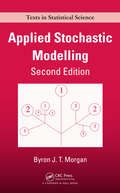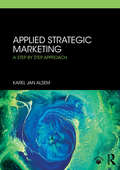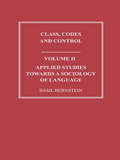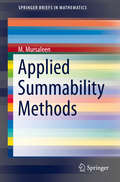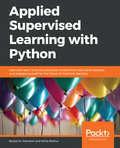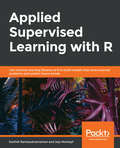- Table View
- List View
Applied Statistics: From Bivariate Through Multivariate Techniques (2nd Edition)
by Rebecca M. WarnerApplied Statistics: From Bivariate Through Multivariate Techniques, Second Edition provides a clear introduction to widely used topics in bivariate and multivariate statistics, including multiple regression, discriminant analysis, MANOVA, factor analysis, and binary logistic regression. The approach is applied and does not require formal mathematics; equations are accompanied by verbal explanations. Students are asked to think about the meaning of equations. Each chapter presents a complete empirical research example to illustrate the application of a specific method. Although SPSS examples are used throughout the book, the conceptual material will be helpful for users of different programs. Each chapter has a glossary and comprehension questions.
Applied Statistics: Handbook of GENSTAT Analysis
by E. J. Snell H. SimpsonGENSTAT is a general purpose statistical computing system with a flexible command language operating on a variety of data structures. It may be used on a number of computer ranges, either interactively for exploratory data analysis, or in batch mode for standard data analysis.The great flexibility of GENSTAT is demonstrated in this handbook by analysing the wide range of examples discussed in Applied Statistics - Principles and Examples (Cox and Snell, 1981). GENSTAT programs are listed for each of the examples. Most of the data sets are small but often it is these seemingly small problems which involve the most tricky statistical and computational procedures. This handbook is self-contained although for a full description of the analysis and interpretation it should be used in parallel with Applied Statistics - Principles and Examples.
Applied Statistics: Theory and Problem Solutions with R
by Dieter Rasch Jürgen Pilz Rob VerdoorenInstructs readers on how to use methods of statistics and experimental design with R software Applied statistics covers both the theory and the application of modern statistical and mathematical modelling techniques to applied problems in industry, public services, commerce, and research. It proceeds from a strong theoretical background, but it is practically oriented to develop one's ability to tackle new and non-standard problems confidently. Taking a practical approach to applied statistics, this user-friendly guide teaches readers how to use methods of statistics and experimental design without going deep into the theory. Applied Statistics: Theory and Problem Solutions with R includes chapters that cover R package sampling procedures, analysis of variance, point estimation, and more. It follows on the heels of Rasch and Schott's Mathematical Statistics via that book's theoretical background—taking the lessons learned from there to another level with this book’s addition of instructions on how to employ the methods using R. But there are two important chapters not mentioned in the theoretical back ground as Generalised Linear Models and Spatial Statistics. Offers a practical over theoretical approach to the subject of applied statistics Provides a pre-experimental as well as post-experimental approach to applied statistics Features classroom tested material Applicable to a wide range of people working in experimental design and all empirical sciences Includes 300 different procedures with R and examples with R-programs for the analysis and for determining minimal experimental sizes Applied Statistics: Theory and Problem Solutions with R will appeal to experimenters, statisticians, mathematicians, and all scientists using statistical procedures in the natural sciences, medicine, and psychology amongst others.
Applied Stochastic Control of Jump Diffusions (Universitext)
by Bernt Øksendal Agnès SulemHere is a rigorous introduction to the most important and useful solution methods of various types of stochastic control problems for jump diffusions and its applications. Discussion includes the dynamic programming method and the maximum principle method, and their relationship. The text emphasises real-world applications, primarily in finance. Results are illustrated by examples, with end-of-chapter exercises including complete solutions. The 2nd edition adds a chapter on optimal control of stochastic partial differential equations driven by Lévy processes, and a new section on optimal stopping with delayed information. Basic knowledge of stochastic analysis, measure theory and partial differential equations is assumed.
Applied Stochastic Differential Equations (Institute of Mathematical Statistics Textbooks #10)
by Simo Särkkä Arno SolinStochastic differential equations are differential equations whose solutions are stochastic processes. They exhibit appealing mathematical properties that are useful in modeling uncertainties and noisy phenomena in many disciplines. This book is motivated by applications of stochastic differential equations in target tracking and medical technology and, in particular, their use in methodologies such as filtering, smoothing, parameter estimation, and machine learning. It builds an intuitive hands-on understanding of what stochastic differential equations are all about, but also covers the essentials of Itô calculus, the central theorems in the field, and such approximation schemes as stochastic Runge–Kutta. Greater emphasis is given to solution methods than to analysis of theoretical properties of the equations. The book's practical approach assumes only prior understanding of ordinary differential equations. The numerous worked examples and end-of-chapter exercises include application-driven derivations and computational assignments. MATLAB/Octave source code is available for download, promoting hands-on work with the methods.
Applied Stochastic Modelling (Chapman & Hall/CRC Texts in Statistical Science)
by Byron J.T. MorganHighlighting modern computational methods, Applied Stochastic Modelling, Second Edition provides students with the practical experience of scientific computing in applied statistics through a range of interesting real-world applications. It also successfully revises standard probability and statistical theory. Along with an updated bibliography and
Applied Stochastic Processes
by Ming LiaoApplied Stochastic Processes presents a concise, graduate-level treatment of the subject, emphasizing applications and practical computation. It also establishes the complete mathematical theory in an accessible way. After reviewing basic probability, the text covers Poisson processes, renewal processes, discrete- and continuous-time Markov chains,
Applied Strategic Marketing: A Step by Step Approach
by Karel Jan AlsemThis book, originally published in Dutch, provides a uniquely practical approach to strategic marketing planning. Combining a comprehensive overview of theory with practice, each chapter takes the reader step by step through the strategic marketing process. Beginning with identifying the value proposition, it moves on to the situational analysis that underpins the corporate strategy, and finally details the overall implementation and creation of a customer and brand values. Applied Strategic Marketing equips the reader with the necessary tools and techniques to develop and deliver a thorough and effective marketing strategy. With a broad range of international case studies that bring the theory to life, this well-renowned and updated translation is vital reading for undergraduate and postgraduate students of marketing management and strategic marketing. It should also be of interest to marketing practitioners who want a clear overview to aid them in the planning process.
Applied Strength of Materials
by Joseph A. Untener Robert MottDesigned for a first course in strength of materials, Applied Strength of Materials has long been the bestseller for Engineering Technology programs because of its comprehensive coverage, and its emphasis on sound fundamentals, applications, and problem-solving techniques. The combination of clear and consistent problem-solving techniques, numerous end-of-chapter problems, and the integration of both analysis and design approaches to strength of materials principles prepares students for subsequent courses and professional practice. The fully updated Sixth Edition. Built around an educational philosophy that stresses active learning, consistent reinforcement of key concepts, and a strong visual component, Applied Strength of Materials, Sixth Edition continues to offer the readers the most thorough and understandable approach to mechanics of materials.
Applied Strength of Materials
by Robert L. Mott Joseph A. UntenerThis text is an established bestseller in engineering technology programs, and the Seventh Edition of Applied Strength of Materials continues to provide comprehensive coverage of the mechanics of materials. Focusing on active learning and consistently reinforcing key concepts, the book is designed to aid students in their first course on the strength of materials. Introducing the theoretical background of the subject, with a strong visual component, the book equips readers with problem-solving techniques. The updated Seventh Edition incorporates new technologies with a strong pedagogical approach. Emphasizing realistic engineering applications for the analysis and design of structural members, mechanical devices, and systems, the book includes such topics as torsional deformation, shearing stresses in beams, pressure vessels, and design properties of materials. A "big picture" overview is included at the beginning of each chapter, and step-by-step problem-solving approaches are used throughout the book. FEATURES Includes "the big picture" introductions that map out chapter coverage and provide a clear context for readers Contains everyday examples to provide context for students of all levels Offers examples from civil, mechanical, and other branches of engineering technology Integrates analysis and design approaches for strength of materials, backed up by real engineering examples Examines the latest tools, techniques, and examples in applied engineering mechanics This book will be of interest to students in the field of engineering technology and materials engineering as an accessible and understandable introduction to a complex field.
Applied Strength of Materials, Sixth Edition SI Units Version
by Robert L. Mott Joseph A. UntenerAPPLIED STRENGTH OF MATERIALS 6/e, SI Units Version provides coverage of basic strength of materials for students in Engineering Technology (4-yr and 2-yr) and uses only SI units. Emphasizing applications, problem solving, design of structural members, mechanical devices and systems, the book has been updated to include coverage of the latest tools, trends, and techniques. Color graphics support visual learning, and illustrate concepts and applications. Numerous instructor resources are offered, including a Solutions Manual, PowerPoint slides, Figure Slides of book figures, and extra problems. With SI units used exclusively, this text is ideal for all Technology programs outside the USA.
Applied Structural Equation Modeling using AMOS: Basic to Advanced Techniques
by Joel E. CollierThis is an essential how-to guide on the application of structural equation modeling (SEM) techniques with the AMOS software, focusing on the practical applications of both simple and advanced topics. Written in an easy-to-understand conversational style, the book covers everything from data collection and screening to confirmatory factor analysis, structural model analysis, mediation, moderation, and more advanced topics such as mixture modeling, censored date, and non-recursive models. Through step-by-step instructions, screen shots, and suggested guidelines for reporting, Collier cuts through abstract definitional perspectives to give insight on how to actually run analysis. Unlike other SEM books, the examples used will often start in SPSS and then transition to AMOS so that the reader can have full confidence in running the analysis from beginning to end. Best practices are also included on topics like how to determine if your SEM model is formative or reflective, making it not just an explanation of SEM topics, but a guide for researchers on how to develop a strong methodology while studying their respective phenomenon of interest. With a focus on practical applications of both basic and advanced topics, and with detailed work-through examples throughout, this book is ideal for experienced researchers and beginners across the behavioral and social sciences.
Applied Structural and Mechanical Vibrations: Theory and Methods, Second Edition
by Paolo L. GattiThe second edition of Applied Structural and Mechanical Vibrations: Theory and Methods continues the first edition's dual focus on the mathematical theory and the practical aspects of engineering vibrations measurement and analysis. This book emphasises the physical concepts, brings together theory and practice, and includes a number of worked-out
Applied Studies Towards a Sociology of Language
by Basil BernsteinThe papers in this second volume show some of the results of the empirical exploration of Bernstein's hypothesis. The volume represents a significant contribution not only to the study of the sociology of language, but also to education and the social sciences. "This collection demonstrates the magnitude of Bernstein's pioneering contribution to socio-linguistic studies" - S. John Eggleston, Times Educational Supplement
Applied Studies in Climate Adaptation
by Sarah L. Boulter Jon Barnett Jean P. Palutikof David RissikThe book advances knowledge about climate change adaptation practices through a series of case studies. It presents important evidence about adaptation practices in agriculture, businesses, the coastal zone, community services, disaster management, ecosystems, indigneous populations, and settlements and infrastructure. In addition to 38 case studies across these sectors, the book contains horizon-scoping essays from international experts in adaptation research, including Hallie Eakin, Susanne Moser, Jonathon Overpeck, Bill Solecki, and Gary Yohe.Australia's social-ecological systems have a long history of adapting to climate variability and change, and in recent decades has been a world-leader in implementing and researching adaptation, making this book of universal relevance to all those working to adapt our environment and societies to climate change.
Applied Summability Methods (SpringerBriefs in Mathematics)
by M. MursaleenThis short monograph is the first book to focus exclusively on the study of summability methods, which have become active areas of research in recent years. The book provides basic definitions of sequence spaces, matrix transformations, regular matrices and some special matrices, making the material accessible to mathematicians who are new to the subject Among the core items covered are the proof of the Prime Number Theorem using Lambert's summability and Wiener's Tauberian theorem, some results on summability tests for singular points of an analytic function, and analytic continuation through Lototski summability Almost summability is introduced to prove Korovkin-type approximation theorems and the last chapters feature statistical summability, statistical approximation, and some applications of summability methods in fixed point theorems.
Applied Superconductivity
by Paul SeidelThis wide-ranging presentation of applied superconductivity, from fundamentals and materials right up to the details of many applications, is an essential reference for physicists and engineers in academic research as well as in industry. Readers looking for a comprehensive overview on basic effects related to superconductivity and superconducting materials will expand their knowledge and understanding of both low and high Tc superconductors with respect to their application. Technology, preparation and characterization are covered for bulk, single crystals, thins fi lms as well as electronic devices, wires and tapes. The main benefit of this work lies in its broad coverage of significant applications in magnets, power engineering, electronics, sensors and quantum metrology. The reader will find information on superconducting magnets for diverse applications like particle physics, fusion research, medicine, and biomagnetism as well as materials processing. SQUIDs and their usage in medicine or geophysics arethoroughly covered, as are superconducting radiation and particle detectors, aspects on superconductor digital electronics, leading readers to quantum computing and new devices.
Applied Supervised Learning with Python: Use scikit-learn to build predictive models from real-world datasets and prepare yourself for the future of machine learning
by Benjamin Johnston Ishita MathurExplore the exciting world of machine learning with the fastest growing technology in the worldKey FeaturesUnderstand various machine learning concepts with real-world examplesImplement a supervised machine learning pipeline from data ingestion to validationGain insights into how you can use machine learning in everyday lifeBook DescriptionMachine learning—the ability of a machine to give right answers based on input data—has revolutionized the way we do business. Applied Supervised Learning with Python provides a rich understanding of how you can apply machine learning techniques in your data science projects using Python. You'll explore Jupyter Notebooks, the technology used commonly in academic and commercial circles with in-line code running support.With the help of fun examples, you'll gain experience working on the Python machine learning toolkit—from performing basic data cleaning and processing to working with a range of regression and classification algorithms. Once you’ve grasped the basics, you'll learn how to build and train your own models using advanced techniques such as decision trees, ensemble modeling, validation, and error metrics. You'll also learn data visualization techniques using powerful Python libraries such as Matplotlib and Seaborn. This book also covers ensemble modeling and random forest classifiers along with other methods for combining results from multiple models, and concludes by delving into cross-validation to test your algorithm and check how well the model works on unseen data.By the end of this book, you'll be equipped to not only work with machine learning algorithms, but also be able to create some of your own!What you will learnUnderstand the concept of supervised learning and its applicationsImplement common supervised learning algorithms using machine learning Python librariesValidate models using the k-fold techniqueBuild your models with decision trees to get results effortlesslyUse ensemble modeling techniques to improve the performance of your modelApply a variety of metrics to compare machine learning modelsWho this book is forApplied Supervised Learning with Python is for you if you want to gain a solid understanding of machine learning using Python. It'll help if you to have some experience in any functional or object-oriented language and a basic understanding of Python libraries and expressions, such as arrays and dictionaries.
Applied Supervised Learning with R: Use machine learning libraries of R to build models that solve business problems and predict future trends
by Jojo Moolayil Karthik RamasubramanianExplore supervised machine learning with R by studying popular real-world uses cases such as object detection in driverless cars, customer churn, and default predictionKey FeaturesStudy supervised learning algorithms by using real-world datasets Fine tune optimal parameters with hyperparameter optimizationSelect the best algorithm using the model evaluation frameworkBook DescriptionR provides excellent visualization features that are essential for exploring data before using it in automated learning. Applied Supervised Learning with R helps you cover the complete process of employing R to develop applications using supervised machine learning algorithms for your business needs. The book starts by helping you develop your analytical thinking to create a problem statement using business inputs and domain research. You will then learn different evaluation metrics that compare various algorithms, and later progress to using these metrics to select the best algorithm for your problem. After finalizing the algorithm you want to use, you will study the hyperparameter optimization technique to fine-tune your set of optimal parameters. To prevent you from overfitting your model, a dedicated section will even demonstrate how you can add various regularization terms.By the end of this book, you will have the advanced skills you need for modeling a supervised machine learning algorithm that precisely fulfills your business needs.What you will learnDevelop analytical thinking to precisely identify a business problemWrangle data with dplyr, tidyr, and reshape2Visualize data with ggplot2Validate your supervised machine learning model using k-fold Optimize hyperparameters with grid and random search, and Bayesian optimizationDeploy your model on Amazon Web Services (AWS) Lambda with plumberImprove your model’s performance with feature selection and dimensionality reductionWho this book is forThis book is specially designed for novice and intermediate-level data analysts, data scientists, and data engineers who want to explore different methods of supervised machine learning and its various use cases. Some background in statistics, probability, calculus, linear algebra, and programming will help you thoroughly understand and follow the content of this book.
Applied Surface Thermodynamics (Surfactant Science)
by Robert David A. Wilhelm Neumann Yi ZuoSurface thermodynamics forms the foundation of any meaningful study of capillarity and wetting phenomena. The second edition of Applied Surface Thermodynamics offers a comprehensive state-of-the-art treatment of this critical topic. It provides students and researchers with fundamental knowledge and practical guidelines in solving real-world proble
Applied Surgical Physiology Vivas
by Mazyar Kanani Martin ElliottAn understanding of basic sciences is the cornerstone of medical and surgical training, and viva examinations in particular remain a source of anxiety for many candidates. Applied Surgery Physiology Vivas follows the same format as the hugely popular General Pathology Vivas and Surgical Critical Care Vivas. It gives candidates a means of practising some of the most common questions that they will be asked in their viva examinations, with detailed model answers and diagrams to highlight key points where necessary. Pocket-sized for portability, and packed with useful information in an easy-to-use A-Z format, this book will help the reader to broaden their knowledge base and, by practising the vivas, gain confidence in their examination technique.
Applied Surrogate Endpoint Evaluation Methods with SAS and R (Chapman & Hall/CRC Biostatistics Series)
by Tomasz Burzykowski Ziv Shkedy Ariel Alonso Theophile Bigirumurame Marc Buyse Geert Molenberghs Leacky Muchene Nolen Joy Perualila Wim Van der ElstAn important factor that affects the duration, complexity and cost of a clinical trial is the endpoint used to study the treatment’s efficacy. When a true endpoint is difficult to use because of such factors as long follow-up times or prohibitive cost, it is sometimes possible to use a surrogate endpoint that can be measured in a more convenient or cost-effective way. This book focuses on the use of surrogate endpoint evaluation methods in practice, using SAS and R.
Applied Survey Data Analysis (Chapman & Hall/CRC Statistics in the Social and Behavioral Sciences)
by Brady T. West Patricia A. Berglund Steven G. HeeringaHighly recommended by the Journal of Official Statistics, The American Statistician, and other journals, Applied Survey Data Analysis, Second Edition provides an up-to-date overview of state-of-the-art approaches to the analysis of complex sample survey data. Building on the wealth of material on practical approaches to descriptive analysis and regression modeling from the first edition, this second edition expands the topics covered and presents more step-by-step examples of modern approaches to the analysis of survey data using the newest statistical software. Designed for readers working in a wide array of disciplines who use survey data in their work, this book continues to provide a useful framework for integrating more in-depth studies of the theory and methods of survey data analysis. An example-driven guide to the applied statistical analysis and interpretation of survey data, the second edition contains many new examples and practical exercises based on recent versions of real-world survey data sets. Although the authors continue to use Stata for most examples in the text, they also continue to offer SAS, SPSS, SUDAAN, R, WesVar, IVEware, and Mplus software code for replicating the examples on the book’s updated website.
Applied Survey Data Analysis (Chapman & Hall/CRC Statistics in the Social and Behavioral Sciences)
by Brady T. West Patricia A. Berglund Steve G. HeeringaHighly recommended by the Journal of Official Statistics, The American Statistician, and other top statistical journals, Applied Survey Data Analysis, Third Edition provides an up-to-date overview of state-of-the-art approaches to the analysis of complex sample survey data. Building on the wealth of material on practical approaches to descriptive analysis and regression modeling from the first and second editions, this third edition further expands the topics covered and presents more step-by-step examples of modern approaches to the analysis of survey data using the newest statistical software procedures.New to the Third Edition: Applied Bayesian methods for the analysis of complex sample survey data using available software implementing these methods State-of-the-art methods and software for the analysis of survey data collected from non-probability samples Software for modern applications of machine learning techniques to complex sample survey data A completely revamped website providing code for replicating all the analyses illustrated in the book using Stata, SAS, SPSS, R, Mplus, SUDAAN, WesVar, and IVEware New end-of-chapter exercises, allowing for practice implementing the methods, including Bayesian analysis exercises Updated summaries of the newest literature on the analysis of survey data collected from complex samples An updated review of software packages currently available for the analysis of complex sample survey data Designed for readers working in a wide array of disciplines who conduct secondary analyses of survey data as part of their applied work, this book continues to provide a practical and accessible guide to the analysis of survey data. Continuing to use an example-driven approach to clearly illustrate analysis methods and software, the third edition contains many new examples and practical exercises based on recent versions of real-world survey data sets. Although the authors continue to use Stata for most examples in the text, they also offer the newest code for replicating the examples in other popular software packages on the book’s revamped website.
Applied Survey Sampling
by Johnny Blair Edward BlairWritten for students and researchers who wish to understand the conceptual and practical aspects of sampling, this book is designed to be accessible without requiring advanced statistical training. It covers a wide range of topics, from the basics of sampling to special topics such as sampling rare populations, sampling organizational populations, and sampling visitors to a place. Using cases and examples to illustrate sampling principles and procedures, the book thoroughly covers the fundamentals of modern survey sampling, and addresses recent changes in the survey environment such as declining response rates, the rise of Internet surveys, the need to accommodate cell phones in telephone surveys, and emerging uses of social media and big data.





